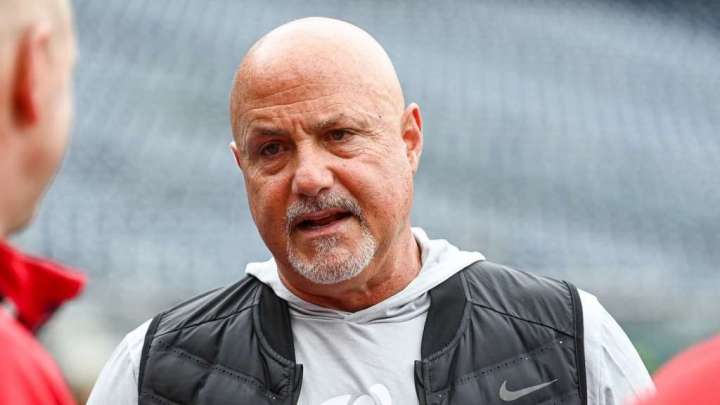Down the hall from the Washington Nationals’ clubhouse, the two entrances to the interview room are blocked by tall black curtains. A “Please Do Not Enter” sign is taped to each. When the team holds Mass behind those doors Sunday mornings, there’s nothing to stop someone from bursting in to bowed heads. But when the Nationals use the space for draft prep — filling it with their amateur scouts from around the country — no risks are taken.
The Nationals hold the No. 5 pick in the draft. The stakes are high.

Ask Mike Rizzo and he will tell you: The three days of Major League Baseball’s draft, set for Sunday through Tuesday, are some of the most important of the year. The general manager wears a suit only on Opening Day and when his club chooses its first player each summer. This July, the Nationals have the fifth pick, their highest since they drafted Bryce Harper first overall in 2010. The last time they were in the top 10 was 2011, when they landed Anthony Rendon at No. 6.
There’s a notable difference between important and critical. In the first full season of a rebuild, their upcoming selection is the latter.
The fifth pick has a slot value of $6,494,300. If the Nationals sign their first selection to a bigger bonus, they would have less money for the rest of their 19 picks. Flip that if they sign him for less than that amount. Logic says that in a draft thin on elite pitchers — and with a minor league system very thin on promising hitters — Washington will take a position player in the first round for the second consecutive year. Many mock drafts have connected the Nationals to Kevin Parada, a 2o-year-old, right-handed-hitting catcher from Georgia Tech.
If those are correct, it’s easy to see the Nationals moving Parada down the line to accommodate Keibert Ruiz. The team views Ruiz, 23, as its catcher of the short- and long-term future. Parada, should they get him, could slide to first base or maybe left field.
But with four teams picking ahead of Washington, any predictions could be upended by the Baltimore Orioles, Arizona Diamondbacks, Texas Rangers or Pittsburgh Pirates. Aside from Parada, the other players regularly projected in the top eight or so picks are outfielder Druw Jones (Wesleyan High in Georgia), shortstop Jackson Holliday (Stillwater High in Oklahoma), outfielder Elijah Green (IMG Academy in Florida), shortstop Brooks Lee (Cal Poly), infielder Termarr Johnson (Mays High in Georgia), third baseman/corner outfielder Jacob Berry (LSU) and third baseman Cam Collier (Chipola Junior College).
For most of the past decade, the Nationals were expected to target tall college pitchers in the early rounds. Think Cade Cavalli, Cole Henry, Jackson Rutledge or Erick Fedde, among a handful of others. But last summer, they directly addressed their needs by selecting a hitter with eight of their first 10 picks. Infielder Brady House, a teenager from Georgia, headlined the class. He was followed by outfielder Daylen Lile, another high school hitter, and Branden Boissiere, a first baseman from the University of Arizona.
If recent trends hold — and again, the draft board is a factor, too — the Nationals will keep filling a wide void of position player prospects. The next question would be whether they feel pressure to pick college players who could rise quickly. And if they do, does that influence just their first pick or their draft strategy as a whole?
The Nationals will select 20 players over three days. They’re still very much in the process of improving a low-ranked farm system and how they develop players. A combination of shortcomings in player development, misses in the draft and trades to stay competitive slimmed the number of homegrown contributors in the past decade. Now, though, last year’s draft, this one and the next few hold extra weight.
With the worst record in baseball entering Saturday’s games, the Nationals are falling toward another high selection in 2023. MLB’s new collective bargaining agreement includes a draft lottery, which means the team with the lowest winning percentage doesn’t automatically get the first pick. Competitive balance rules almost will limit teams from being in the top five in back-to-back seasons, a revision that will kick in for 2023 and 2024.
No matter what, expect the public message to be that the Nationals chose some combination of the best fit and best available at No. 5. But throughout this dismal season, Rizzo has often predicted a fast rebuild. Nailing a close-to-ready hitter could push it along. Of course, Washington could fast-track a pick as a teenager or a 20-year-old. Rizzo did that with Harper, Juan Soto, Victor Robles and Luis García. His impatience — not to mention the urgency to build another winner around Soto — makes it at least somewhat liable to happen again.
Parada, Lee or Berry come with Division I college experience. When assessing position players, the Nationals have liked to build through the middle with catchers, shortstops and center fielders, made evident in their recent drafts and international signing classes. Perhaps that means Green, a high school center fielder, is a logical choice if he’s there. Last fall, a Nationals scout raved about Green’s potential, calling him one of the best talents to come out in a while.
Yet that was a long time ago. In recent months, Rizzo missed road trips, something he rarely does, to attend the ACC tournament, the SEC tournament and the draft combine in San Diego. The organization invested in amateur scouting in the offseason, giving Kris Kline, its assistant GM in charge of the draft, a full staff to cover the country. There’s a lot to consider behind those black curtains.






